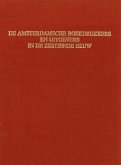In bondige beschrijvingen en commentaren wordt overtuigend aangetoond dat Van Deventer zijn tijd ver vooruit was met onder andere zijn opsomming van eigenschappen die men moet hebben om een goed verloskundige te zijn... De helder geschreven teksten, de fraaie historische prenten en de verklarende woordenlijst achterin maken dit boekwerk goed toegankelijk.
Towards the end of the 17th century, Hendrik van Deventer was breaking new ground with his work for the obstetrician and the midwife. This became the first work on obstetrics to be written in the Dutch language and was to have a considerable influence on the practice of obstetrics in the 18th century. Van Deventer (1651-1724), a famous physician, had already published a scientific paper in which - thoroughly in the spirit of the Enlightenment - he had firmly coupled the theoretical and the practical. His theories are based upon years of practical experience. Until recently, there has been no facsimile edition of his work. To mark the ten years since the inauguration of the Study Group for the History of the Netherlands Association of Obstetrics and Gynaecology, attention is once again focussed on Hendrik van Deventer and his Manuele Operatien, zynde een Nieuw Ligt. The facsimile is based upon the 1746 publication. Van Deventer's work is at its most complete in this edition. Included are, additionally, what the author has left behind: Nader vertoog van de swaare baringen and his Nieuwe Aanmerkingen, and in translation from the French Aanmerkingen by Jacques Jean Bruier d'Ablaincourt. The facsimile is published together with a separate commentary, in Dutch, prefaced with three articles covering Van Deventer's life and work. In the following eight pieces, the topics of Manuele Operatien, zynde een Nieuw Ligt are reviewed under the periods in which they were set down and commentaries added. A glossary, together with an extended historical bibliography is included, thus ensuring this work as an essential source of the history of gynaecology and obstetrics in the Netherlands.
Hinweis: Dieser Artikel kann nur an eine deutsche Lieferadresse ausgeliefert werden.
Towards the end of the 17th century, Hendrik van Deventer was breaking new ground with his work for the obstetrician and the midwife. This became the first work on obstetrics to be written in the Dutch language and was to have a considerable influence on the practice of obstetrics in the 18th century. Van Deventer (1651-1724), a famous physician, had already published a scientific paper in which - thoroughly in the spirit of the Enlightenment - he had firmly coupled the theoretical and the practical. His theories are based upon years of practical experience. Until recently, there has been no facsimile edition of his work. To mark the ten years since the inauguration of the Study Group for the History of the Netherlands Association of Obstetrics and Gynaecology, attention is once again focussed on Hendrik van Deventer and his Manuele Operatien, zynde een Nieuw Ligt. The facsimile is based upon the 1746 publication. Van Deventer's work is at its most complete in this edition. Included are, additionally, what the author has left behind: Nader vertoog van de swaare baringen and his Nieuwe Aanmerkingen, and in translation from the French Aanmerkingen by Jacques Jean Bruier d'Ablaincourt. The facsimile is published together with a separate commentary, in Dutch, prefaced with three articles covering Van Deventer's life and work. In the following eight pieces, the topics of Manuele Operatien, zynde een Nieuw Ligt are reviewed under the periods in which they were set down and commentaries added. A glossary, together with an extended historical bibliography is included, thus ensuring this work as an essential source of the history of gynaecology and obstetrics in the Netherlands.
Hinweis: Dieser Artikel kann nur an eine deutsche Lieferadresse ausgeliefert werden.









